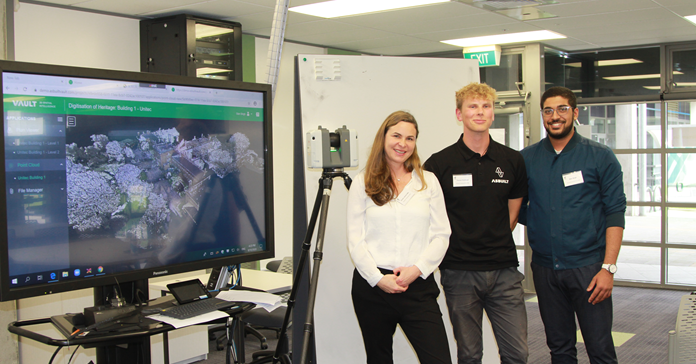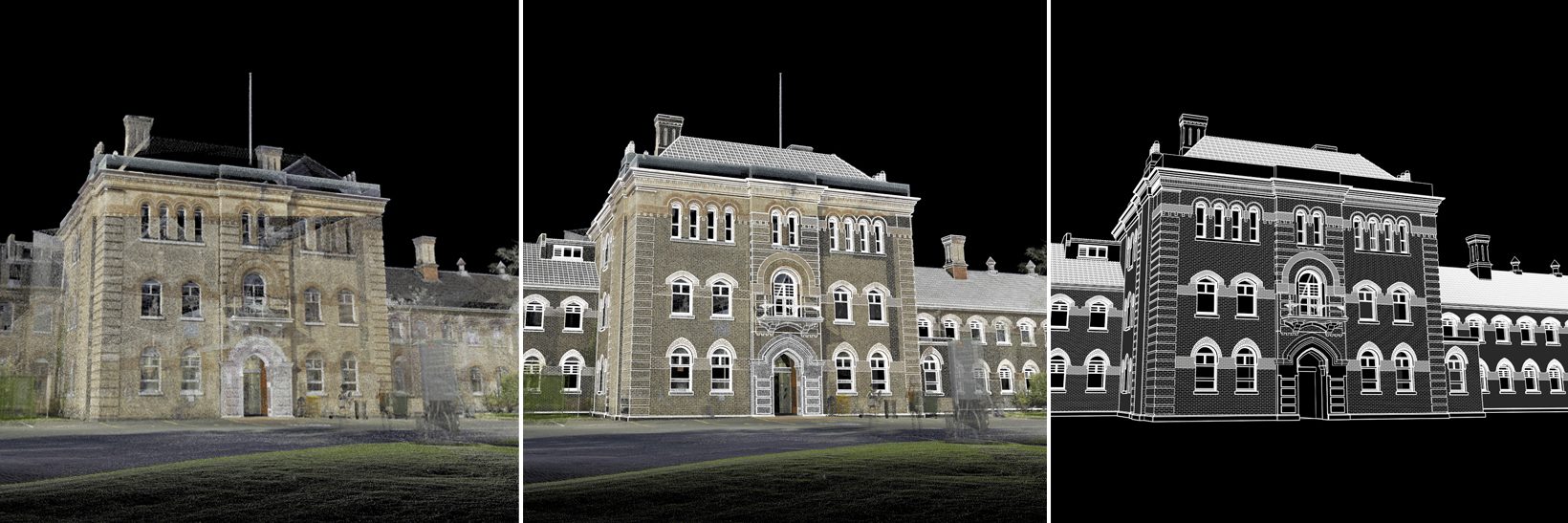What we do
Modern technologies for digital heritage include 3D laser scanning; Photogrammetric 3D models of buildings, sites, and objects; and HBIM (historic building information modelling) software.
Not all heritage can be physically retained, and much has been lost. The use of Modern digital technologies not only facilitate and improve conservation practices and processes, but also enable the creation of a digital database of heritage. The Unitec Digital Heritage Research Centre investigates how to:
- Raise awareness and implement the utilisation of modern technologies for digital heritage in the related professions and sectors, including architecture, heritage conservation, and government.
- Improve education in the use of modern technologies for digital heritage.
- Enhance implementation of modern technologies for digital heritage.
Benefits of digital scanning include:
- Digital Heritage: Create computer-based materials of enduring value, accessible to future generations.
- Strategic approach to heritage conservation can be developed, maintaining the continuity of heritage buildings. Digital data enables close monitoring of the rate of decay or damage to structures over time.
- Disaster Remediation: Maintain a digital library of information that can be used to repair and preserve irreplaceable heritage sites in case of natural or other disasters.
- Educational Tool: Assists new generations of architects and other professionals in learning about the importance of heritage protection and preservation, and how to work collaboratively with local communities and agencies towards a common goal.
- Remote Access: Digital data enables the creation of digital models and virtual tours, allowing remote access to inaccessible or dangerous areas from specialists nationally and across the world through virtual reality.
- Climate Consideration: Retaining built heritage and adaptive reuse of buildings prevents established embodied energy in wholesale buildings and their materials from being sent to landfills.
- Global Collaboration: Technical data (Point Clouds and BIM) can be used to create interactive and online-based materials that can be shared with contractors globally, minimising site visits and reducing contractor carbon footprint.
Current research
The Digital Heritage Research Centre is dedicated to the digital recording and modelling of historical and heritage buildings. Our work exemplifies the collaboration between education, community, and industry, and we strongly advocate for the integration of digital technologies in domestic conservation practices, particularly within architectural education institutions.
Our recent and current projects involve the scanning (using LiDAR and Photogrammetry technology) and 3D modelling of:

- Building 1: Until 2020, part of the Unitec Mt Albert campus, this heritage building was formerly known as Oakley or Carrington Hospital, originally established as the Lunatic Asylum of the ‘Whau’.
- Colonial Ammunition Shot Tower (image on the right): Located in Mt Eden in Auckland, this was the last remaining 20th-century tower of its kind in Australasia. Due to safety concerns ahead of Cyclone Gabrielle, engineers determined it was a risk to life and property, leading to its demolition.
- St David’s Memorial Church: Situated on Khyber Pass, this project involves close collaboration with the community Friends of St David’s Trust and industry partners; to complete detailed digital recording and modelling to preserve its historical significance.
Additionally, extensive engagement with external partners through focus groups will assist the research centre gain valuable insights into:
- Understanding of Digital Heritage: Assessing the current levels of knowledge and familiarity with digital heritage tools, equipment, and software among professionals, architects, heritage architects, and cultural heritage experts.
- Prioritisation of Heritage Buildings: Identifying which heritage buildings should be prioritised for digital recording to ensure their preservation.
- Enhancing Conservation Practices: Exploring ways to improve the management and conservation of heritage buildings in Aotearoa New Zealand through the application of modern digital technologies.

Caption: LiDar scanning workshops with industry partners and students. Source: Unitec Research Project “Digitalisation of Heritage in NZ”.

Point cloud of the main façade of Building One. Source: Unitec Research Project “Digitalisation of Heritage in NZ”

Unitec Research Project “Digitalisation of Heritage in NZ” inaugural (core) team members: Renata Jadresin Milic; Thomas Reutlinger, Sian Singh.
Research publications
Published research from the Digital Heritage research centre:
Transdisciplinary Digital Heritage Research Centre Development: Applied Research towards a More Resilient Environment.
Book: Integrating Resiliency into Future Sustainable Cities, Hasim Altan, Sameh Shamout, Matthew Bradbury, Yusef Patel (Ed.). Switzerland: Springer, 2024. https://link.springer.com/book/9783031632020
Date published: September 2024.
Hardcover ISBN978-3-031-63202-0 Due: 29 October 2024
Authors: Renata Jadresin Milic, Viola Vadász, and Iman Khan
Learning from practice in the digital age: ‘Digitalisation of heritage in New Zealand.’
Architectural Science Review, July (2024) 1–15. https://doi.org/10.1080/00038628.2024.2371057
Date published: July 2024
Authors: Iman Khan, Renata Jadresin Milic, Bin Su, and Viola Vadász.
Scanning the Mt Eden Shot Tower.
ICOMOS Aotearoa New Zealand Newsletter, March 2024, pp. 2-5. ISSN 0113-2237. Newsletter March 2024 – Icomos
Date published: March 2024
Authors: Renata Jadresin Milic, Regan Potangaroa, and Sam Smith.
Project Methodology and Workflow for Emergency Drone Recording and Processing: Case study Colonial Ammunition Company Shot Tower, Aotearoa New Zealand.
DISEGNARECON Journal, Vol 16, No 31, (2023) 1.1-1.9. doi: https://doi.org/10.20365/disegnarecon.31.2023.1
Date published: December 2023
Authors: Regan Potangaroa, Renata Jadresin Milic, and Sam Smith.
Is Our Heritage Falling Through the Gaps?
Asylum, Vol.2, December 2023, 322-329. doi: https://doi.org/10.34074/aslm.2023206.
Date published: December 2023
Authors: Viola Vadász, Renata Jadresin Milic, and Iman Khan.
Digital Heritage Research Centre and Degrees of Complexity in IMAGIN(G) Heritage in Aotearoa.
Invited keynote “IMAGIN(G) HERITAGE”. 4th International and Interdisciplinary Conference on Image and Imagination. L’Aquila, Italy, July 6-7, 2023 (http://www.img-network.it/conference-2023/)
Authors: Renata Jadresin Milic.
Architectural History and Sustainable Architectural Heritage Education: Digitalisation of Heritage in New Zealand.
Sustainability 2022, 14, 16432. https://doi.org/10.3390/su142416432, webpage: https://www.mdpi.com/2071-1050/14/24/16432.
Date published: 8 December 2022
Authors: Renata Jadresin Milic, Peter McPherson, Graeme McConchie,Thomas Reutlinger, and Sian Singh.
The Digital Realm and New Zealand Heritage: Bringing Architectural Theory and Practice into the Modern Architects Workflow.
“Heritage Bites” – Digital lunchtime talks on historic heritage matters, Historic Places Aotearoa and ICOMOS New Zealand.
View the presentation on YouTube.
Date published: 1 April 2022.
Authors: Dr Renata Jadresin Milic, Thomas Reutlinger, Sian Singh.
The Digital Realm and New Zealand Heritage – Challenges and Potentials.
Paper presented at the Rangahau Horonuku Hou New Research Landscapes, MIT – Unitec Research Symposium 2021, Auckland, Unitec New Zealand.
Date published: December 2021.
Authors: Dr Renata Jadresin Milic, Thomas Reutlinger, Sian Singh.
Teaching Architectural History Starting From Current Events: Digitalisation of Heritage in New Zealand.
Paper presented at What if? What next? Speculations on History’s Futures. 37th Annual Conference of the Society of Architectural Historians, Australia and New Zealand, Perth.
Date published: November 2020.
Authors: Dr Renata Jadresin Milic, Peter McPherson, Graeme McConchie
Digitalisation of New Zealand Architectural Heritage: Bringing Architectural History and Theory into the Virtual Realm.
Paper presented at the Whaowhia te kete mātauranga – Fill the basket of knowledge. Unitec Research Symposium 2020, Auckland, Unitec New Zealand.
Date published: October 2020.
Authors: Dr Renata Jadresin Milic, Thomas Reutlinger, Sian Singh.
Preservation issues and controversies: Challenges of underutilised and abandoned places.
Link to article in Research bank.
In A. Ghaffarianhoseini, A. Ghaffarianhoseini and N. Nasmith (Ed.), Imaginable Futures: Design Thinking, and the Scientific Method, 54th International Conference of the Architectural Science Association 2020, Auckland University of Technology, Auckland, New Zealand (pp. 885-894).
Date published: October 2020.
Authors: Julia Hamilton, Dr. Renata Jadresin Milic.
Contact the Digital Heritage Research Centre
Email: Dr Renata Jadresin Milic rjadresinmilic@unitec.ac.nz
Physical address: Unitec, Te Whare Wānanga o Wairaka, 139 Carrington Road, Mount Albert, Auckland New Zealand.
Our research partners
- Professor Regan Potangaroa (Massey University, Auckland).
- Mari McKee and Tracey Hartley (Salmond Reed Architects).
- Simon Mobley and Freddie Nodalo (AsBuilt Digital).
- Malcolm Archbold, (Survis limited – The legacy of his contribution to the establishment of this centre will endure, despite his recent passing).
- Chirag Jindal (Arclab).
- Point Chevalier Community Trust.
- Sam Smith (Woods).
- Tim Stevenson (Archifact – Architecture and conservation limited).
- Auckland Council – Heritage Unit.
- Friends of St David’s Trust.
- Human Interface Technology (HIT) Lab NZ (University of Canterbury).
- Orbica Ltd.
- Politecnico di Milano, Italy.
- University of L’Aquila, Italy.
- University of Firenze, Italy.
- Cracow University of Technology, Poland.
- Norwegian University of Science and Technology, Norway.
- University of Belgrade, Serbia.
- Iowa State University, USA.
- Vanderbilt University, USA.
- The University of Queensland, Australia.
- INTBAU Australia
